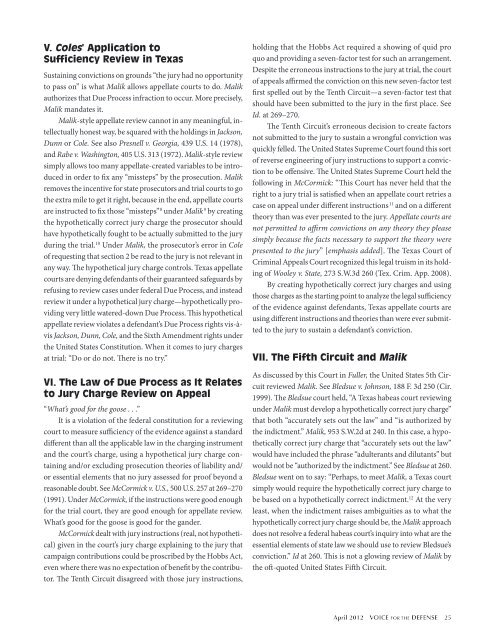for the defense for the defense - Voice For The Defense Online
for the defense for the defense - Voice For The Defense Online
for the defense for the defense - Voice For The Defense Online
Create successful ePaper yourself
Turn your PDF publications into a flip-book with our unique Google optimized e-Paper software.
V. Coles’ Application toSufficiency Review in TexasSustaining convictions on grounds “<strong>the</strong> jury had no opportunityto pass on” is what Malik allows appellate courts to do. Malikauthorizes that Due Process infraction to occur. More precisely,Malik mandates it.Malik-style appellate review cannot in any meaningful, intellectuallyhonest way, be squared with <strong>the</strong> holdings in Jackson,Dunn or Cole. See also Presnell v. Georgia, 439 U.S. 14 (1978),and Rabe v. Washington, 405 U.S. 313 (1972). Malik-style reviewsimply allows too many appellate-created variables to be introducedin order to fix any “missteps” by <strong>the</strong> prosecution. Malikremoves <strong>the</strong> incentive <strong>for</strong> state prosecutors and trial courts to go<strong>the</strong> extra mile to get it right, because in <strong>the</strong> end, appellate courtsare instructed to fix those “missteps” 8 under Malik 9 by creating<strong>the</strong> hypo<strong>the</strong>tically correct jury charge <strong>the</strong> prosecutor shouldhave hypo<strong>the</strong>tically fought to be actually submitted to <strong>the</strong> juryduring <strong>the</strong> trial. 10 Under Malik, <strong>the</strong> prosecutor’s error in Coleof requesting that section 2 be read to <strong>the</strong> jury is not relevant inany way. <strong>The</strong> hypo<strong>the</strong>tical jury charge controls. Texas appellatecourts are denying defendants of <strong>the</strong>ir guaranteed safeguards byrefusing to review cases under federal Due Process, and insteadreview it under a hypo<strong>the</strong>tical jury charge—hypo<strong>the</strong>tically providingvery little watered-down Due Process. This hypo<strong>the</strong>ticalappellate review violates a defendant’s Due Process rights vis-àvisJackson, Dunn, Cole, and <strong>the</strong> Sixth Amendment rights under<strong>the</strong> United States Constitution. When it comes to jury chargesat trial: “Do or do not. <strong>The</strong>re is no try.”VI. <strong>The</strong> Law of Due Process as It Relatesto Jury Charge Review on Appeal“What’s good <strong>for</strong> <strong>the</strong> goose . . .”It is a violation of <strong>the</strong> federal constitution <strong>for</strong> a reviewingcourt to measure sufficiency of <strong>the</strong> evidence against a standarddifferent than all <strong>the</strong> applicable law in <strong>the</strong> charging instrumentand <strong>the</strong> court’s charge, using a hypo<strong>the</strong>tical jury charge containingand/or excluding prosecution <strong>the</strong>ories of liability and/or essential elements that no jury assessed <strong>for</strong> proof beyond areasonable doubt. See McCormick v. U.S., 500 U.S. 257 at 269–270(1991). Under McCormick, if <strong>the</strong> instructions were good enough<strong>for</strong> <strong>the</strong> trial court, <strong>the</strong>y are good enough <strong>for</strong> appellate review.What’s good <strong>for</strong> <strong>the</strong> goose is good <strong>for</strong> <strong>the</strong> gander.McCormick dealt with jury instructions (real, not hypo<strong>the</strong>tical)given in <strong>the</strong> court’s jury charge explaining to <strong>the</strong> jury thatcampaign contributions could be proscribed by <strong>the</strong> Hobbs Act,even where <strong>the</strong>re was no expectation of benefit by <strong>the</strong> contributor.<strong>The</strong> Tenth Circuit disagreed with those jury instructions,holding that <strong>the</strong> Hobbs Act required a showing of quid proquo and providing a seven-factor test <strong>for</strong> such an arrangement.Despite <strong>the</strong> erroneous instructions to <strong>the</strong> jury at trial, <strong>the</strong> courtof appeals affirmed <strong>the</strong> conviction on this new seven-factor testfirst spelled out by <strong>the</strong> Tenth Circuit—a seven-factor test thatshould have been submitted to <strong>the</strong> jury in <strong>the</strong> first place. SeeId. at 269–270.<strong>The</strong> Tenth Circuit’s erroneous decision to create factorsnot submitted to <strong>the</strong> jury to sustain a wrongful conviction wasquickly felled. <strong>The</strong> United States Supreme Court found this sortof reverse engineering of jury instructions to support a convictionto be offensive. <strong>The</strong> United States Supreme Court held <strong>the</strong>following in McCormick: “This Court has never held that <strong>the</strong>right to a jury trial is satisfied when an appellate court retries acase on appeal under different instructions 11 and on a different<strong>the</strong>ory than was ever presented to <strong>the</strong> jury. Appellate courts arenot permitted to affirm convictions on any <strong>the</strong>ory <strong>the</strong>y pleasesimply because <strong>the</strong> facts necessary to support <strong>the</strong> <strong>the</strong>ory werepresented to <strong>the</strong> jury” [emphasis added]. <strong>The</strong> Texas Court ofCriminal Appeals Court recognized this legal truism in its holdingof Wooley v. State, 273 S.W.3d 260 (Tex. Crim. App. 2008).By creating hypo<strong>the</strong>tically correct jury charges and usingthose charges as <strong>the</strong> starting point to analyze <strong>the</strong> legal sufficiencyof <strong>the</strong> evidence against defendants, Texas appellate courts areusing different instructions and <strong>the</strong>ories than were ever submittedto <strong>the</strong> jury to sustain a defendant’s conviction.VII. <strong>The</strong> Fifth Circuit and MalikAs discussed by this Court in Fuller, <strong>the</strong> United States 5th Circuitreviewed Malik. See Bledsue v. Johnson, 188 F. 3d 250 (Cir.1999). <strong>The</strong> Bledsue court held, “A Texas habeas court reviewingunder Malik must develop a hypo<strong>the</strong>tically correct jury charge”that both “accurately sets out <strong>the</strong> law” and “is authorized by<strong>the</strong> indictment.” Malik, 953 S.W.2d at 240. In this case, a hypo<strong>the</strong>ticallycorrect jury charge that “accurately sets out <strong>the</strong> law”would have included <strong>the</strong> phrase “adulterants and dilutants” butwould not be “authorized by <strong>the</strong> indictment.” See Bledsue at 260.Bledsue went on to say: “Perhaps, to meet Malik, a Texas courtsimply would require <strong>the</strong> hypo<strong>the</strong>tically correct jury charge tobe based on a hypo<strong>the</strong>tically correct indictment. 12 At <strong>the</strong> veryleast, when <strong>the</strong> indictment raises ambiguities as to what <strong>the</strong>hypo<strong>the</strong>tically correct jury charge should be, <strong>the</strong> Malik approachdoes not resolve a federal habeas court’s inquiry into what are <strong>the</strong>essential elements of state law we should use to review Bledsue’sconviction.” Id at 260. This is not a glowing review of Malik by<strong>the</strong> oft-quoted United States Fifth Circuit.
















